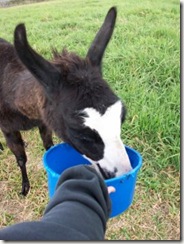The llama is getting a little tamer these days. I think having lived here for about a year now, she’s adjusted more and gotten used to me, all the dogs, and the layout of the place. She is much less flighty.
Category: Llama
Last KHSI Notes on Grass: RCG in the Northwest
My last bit of learning from Woody Lane’s class on grass actually happened at the lunch table. I had the good fortune of sitting by him, so got another whole hour of his knowledge! The topic of discussion was of great interest to me: reed canary grass (RCG), because we have a lot of it. The above picture is what our RCG looked like when we first started to tackle it, during the winter, it would lay in dead layers of brown like this. Beyond it, you can see a field of more “normal” green pasture grass that had been well-maintained by the prior property owner, cut for cow silage multiple times per season.
Continue reading “Last KHSI Notes on Grass: RCG in the Northwest”
Llama Shearing

Here is a little pictorial of the llama shearing event last weekend. Above is the “before” nappy hair shot. She was definitely long overdue for a shear! Continue reading “Llama Shearing”
The Llama’s New ‘Do
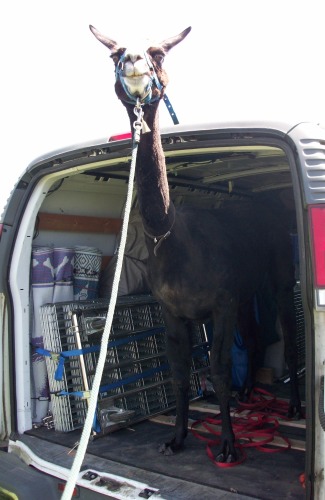
A local feed store and some alpaca farmers organized a shearing event for today, held in the parking lot of the feed store. It was a great deal- $16 per llama or alpaca, much less expensive than hiring a shearer to come out to the farm to do one animal. I had been wanting to shear Dolly Llama soon, and was dreading trying to do it myself, she was one shaggy monster. So I was thrilled to see a flyer for this event last week. Continue reading “The Llama’s New ‘Do”
The Odd Couple: Ears, Eyes, Bark and Bite
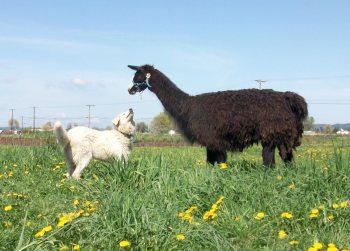 Here is our livestock guardian pair, displaying their somewhat adversarial relationship. Neither one is really afraid of the other, and they haven’t thus far hurt each other and don’t seem to have intent to. But, the dog enjoys getting some sport out of hassling the llama by barking at her, and leaping up to air-snap at her head. This annoys the llama to no end, and she swings her long neck around with flattened ears, trying to communicate her irritation. Sometimes she even spits at the dog, but the dog doesn’t mind and keeps at her lively sport. 🙂 Continue reading “The Odd Couple: Ears, Eyes, Bark and Bite”
Here is our livestock guardian pair, displaying their somewhat adversarial relationship. Neither one is really afraid of the other, and they haven’t thus far hurt each other and don’t seem to have intent to. But, the dog enjoys getting some sport out of hassling the llama by barking at her, and leaping up to air-snap at her head. This annoys the llama to no end, and she swings her long neck around with flattened ears, trying to communicate her irritation. Sometimes she even spits at the dog, but the dog doesn’t mind and keeps at her lively sport. 🙂 Continue reading “The Odd Couple: Ears, Eyes, Bark and Bite”
Living With Coyotes: Part 2
 How to live in balance with your local coyote population? Here’s some of my thinking and learning thus far.
How to live in balance with your local coyote population? Here’s some of my thinking and learning thus far.
Of course the first temptation is to shoot at them, there is a very alluring promise of an immediate sense of “justice” and relief of seeing that thief dead! Removing certain animals from the population is a valid part of predator management. But, only a part. Continue reading “Living With Coyotes: Part 2”
Herding Mayhem
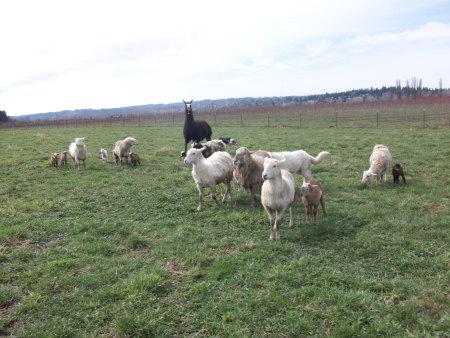 When we got Bronte the LGD, I was a bit worried about how things would go when she was first introduced to the Border Collies. While she was penned with the sheep in the small pen, if the Border Collies passed by outside the pen, she would snarl and threaten them. Which is good, it’s her job to deter strange dogs that look like they want to eat the sheep. But, clearly it would be ideal if the Border Collies could work without having to to lock up the LGD.
When we got Bronte the LGD, I was a bit worried about how things would go when she was first introduced to the Border Collies. While she was penned with the sheep in the small pen, if the Border Collies passed by outside the pen, she would snarl and threaten them. Which is good, it’s her job to deter strange dogs that look like they want to eat the sheep. But, clearly it would be ideal if the Border Collies could work without having to to lock up the LGD.
It turns out, there was nothing to worry about. When I first moved the sheep down to the pasture, a few times I had to work them, to get them into their Electronet pen. So, I just did it, to see how it would go. And Bronte was OK with it. The only annoying thing is she definitely gets in the mix. She is curious about the Border Collies, and wishes they would play. But, they ignore her, like she is a gnat flying around in their field of view, not a nearly 100 pound pup trying to pounce on them! They have zero interest in play or fraternizing with other dogs when there are sheep to work.
So, it makes for challenging herding. Bronte switches between getting in the way of the collies and getting in the middle of the sheep, and then sometimes throws in some llama-hassling for fun, too. It’s good practice for the collies, they really have to handle a lot of different pressure points when there is a dog running randomly through the sheep, the llama is sparring with the dog, and then the ewes are all stubborn and protective of their lambs and don’t want to move.
In this photo, you can see Maggie way in the back, behind the llama (who is showing her Angry Ears at this process). Maggie is trying to get this crowd bunched together and moving towards me. But Bronte is strolling through the middle, with her tail high in delight over the mayhem. The ewes are all spread out, and they turn on Maggie and stomp if she pushes too hard. But, she is able to get the job done, with some patience and an occassional, warranted grip.
I haven’t been working Gene as much, because this is very difficult for her and takes more time. Gene will feel too much pressure and kick out “into orbit,” and it’s hard for me to call her in to work the sheep consistently with all this chaos, she doesn’t like it. And, if she is off contact, the sheep spread too much, Bronte starts pulling on lamb tails and legs, and I start to yell! Hopefully a little later in the summer Gene will get some more chances to work, once Maggie has the lambs all dog broke.
Maggie is also the best tempered for the chore I am doing every three days now: moving the Electronet “square.” Maggie is “sticky” – she loves nothing more than to get sucked into the sheep, using her eye, and get them in a deadlock where nobody is moving. This is a very annoying trait when I want her to move them and she is frozen in space and time, and no amount of verbal commanding can un-stick her. But, it comes in handy when I need her to hold! I can park her anywhere holding the sheep and leave her, and she’ll keep them there.
So, when I’m ready to move the square, I park Maggie in the sheep in one corner of it. I move the other corner, then move Maggie and the sheep into it. Then I move the other half and box them all back in, and call Maggie off. I find that having Maggie hold the sheep in a tight bunch makes things less risky while Bronte has access to the sheep. She is less stimulated by that, versus having the sheep spread out in the pasture, where she can start to chase them and get to tugging on the lambs. I don’t want her to get in the habit of this, so I try to keep things very boring for her when she has a few minutes “in” with the sheep.
LGD Introductory Training
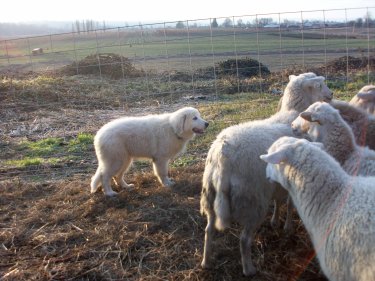 Here’s how I think it’s going to work integrating the LGD into the mix. I’m not confident that all will play out as planned. But I’ll have to be flexible and adjust the plan as I see how things are going, because I don’t really know how things will go!
Here’s how I think it’s going to work integrating the LGD into the mix. I’m not confident that all will play out as planned. But I’ll have to be flexible and adjust the plan as I see how things are going, because I don’t really know how things will go!
Now:LGD is in a small pen with all the sheep. The idea being that she will be lonely and bond with them, not having much other company to prefer. And, that they will acclimate to her presence, having no way to get very far away from her. This part is going swimmingly- she already easily moves amongst them with little disturbance on their part, they tolerate her calmly, and she really seems to like them.
She is starting to try to play with them dog-style a little bit, which is not ideal, but expected. The lamb is already a good 20lbs, so should be able to remove himself from her silliness if he needs to, and the rest of them are big enough to butt her if she gets on their nerves. As the other ewes lamb, I’ll remove them to a separate pen for as long as I can, to give the lambs a chance to grow a little before having to contend with the dog.
The other good thing that’s happening now is the LGD is barking at night and barking at anything that approaches the pen. This should be putting the coyotes on notice that there is now a big dog in the picture. Hopefully they’ll just start steering clear of anyplace they hear her barking. And she’ll be gaining confidence that when she barks, she is able to make intruders leave.
ASAP: get that dog more tame and leash-broken. The 1st day she was here; she was stressed, and fairly demure. The 2nd day, she was feeling her loneliness, so was very solicitous of our attentions. But by the 3rd day, she’s bonded to the sheep, and is playing a bit of keep-away with people and getting very silly. Before she can leave that pen, she needs to come when she’s called and be able to walk reasonably on a leash. I suppose those are the only two people skills she’ll ever need to have!
Soon: catch the llama and move her up to the pen, so she can also acclimate to the dog. Fill in the gaps under the gates to make it harder for coyotes to get into the pasture.
At the end of the month: move the dog and all but three sheep back down to the pasture. Keep the three ewes that are due in March up by the house, with the llama, until they all lamb and can be turned back out. Since I don’t know when the Jacob ewe is due, I may let her take her chances pasture-lambing rather than have her potentially penned up all spring, waiting for her due date.
I’ve been planning to buy portable electro-net fencing in the future, so I can utilize it to do rotational grazing. That purchase is now higher priority, because I feel it’ll be safer to move the dog and sheep down into a smaller area within the big pasture. That way, the dog and sheep can spend more time bonding, the sheep won’t get too far away from the dog’s protection, and the hotwire will offer some protection from coyotes to all of them until things are more stabilized.
A Little Home Llama Dentistry…
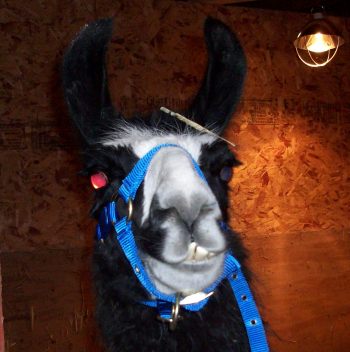
Our llama is an older lady, and we don’t know her whole history. Suffice to say it may not have been ideal. One thing I noticed as soon as we got her is that her teeth stuck out of her lips and grew at an odd angle. I’m not a llama expert, but llama teeth look like they’re configured the same as sheep- they have lower front teeth for grass cutting, that mesh with a hard upper dental plate/gum. Ideally, they should line up so that they can tear grass. Dolly’s clearly did not. I could see that when she grazed, she had to flip her head quite a bit to rip grass off, which is probably not efficient.
I’m not sure what causes this condition, but I suspect the primary cause may be no natural grazing, in an animal that’s fed hay and grain year-round (which I believe Dolly was before we got her). Eating hay and grain only requires gobbling up feed and grinding it with the back teeth, so the front teeth probably get no wear. The front teeth are designed by nature to continually grow, to compensate for incredible wear they’d normally experience from grazing. Dolly’s teeth were not only too long, however, they grew more horizontally than I would expect, and were curving to the side. I’m not sure what to think about that- perhaps it is congenital, or perhaps her too-tight halter played a role. Anyway, it needed to be fixed, because at our house, she needs to graze.
I searched for information on this condition, but found relatively little in my books at home and also on the Internet. Most mention of llama teeth is in relation to cutting fighting teeth off of male llamas- so at least I knew the teeth can be cut. I found this $219 value, intimidatingly large tooth cutting implement, the Tooth-A-Matic, but I can’t justify buying such a thing for possibly a one-time use. (It does look like it might be great if you found yourself needing to cut llama teeth very often!)
Finally I found this really helpful article, written by Eric Hoffman, complete with clear pictures, on using a Dremel tool to grind teeth down. Ok, that didn’t sound so technical once I read that. Dolly’s place on our farm is to protect our sheep investment (and she’s not doing a very good job of that even), and I really don’t want her to become a big investment in her own right. So I’d prefer to avoid vet bills if at all possible, and I am pretty comfortable doing a lot of basic medical things on animals. But, I’d avoided tackling her to do this kind of dentistry experiment, knowing that it would only add to her wariness of us, at a time when I want her to become more tame and trusting.
But, while she was in the barn recovering from her surfing stunt, I decided it was time. I didn’t want to let it go too long, because I was concerned about her ability to keep weight on if she cannot graze effectively. I didn’t know when I’d have her as a captive audience again, and I figured it would be better to do something “mean” to her in my parents’ barn, so at least she’d not associate it to being caught in our field.

So, I did it, and it turned out to be really easy! I had envisioned a possible rodeo with her bucking all over, and me and my Dremel tool going flying, resulting in me crying Uncle and calling a vet. But, not at all, she was very good. I used a metal grinder attachment for my Dremel, the kind with diamond-shaped scores along a wide cylinder. My mom helped me, and at first we did stick a broom handle in her mouth to help keep her lips and tongue out of the way. But at some point, it fell out and I ended up finishing the job just with my leather-gloved thumb holding her mouth open. She was surprisingly calm about the endeavor, and it only took a few minutes. I nicked her once in the lip somewhere just a little bit, such that there was a trickle of blood, but that was the worst of it.
I wasn’t able to get her teeth as aligned to her dental plate as I would have wished, because they are not growing at a vertical enough angle towards the plate to make a clear location of contact/meshing. And I didn’t want to take TOO much off- I wasn’t sure if I’d eventually hit the roots of the teeth and cause her pain. But, I was pretty satisfied with the result- at least they are all pretty even now, and closer to ideal. And now they only stick out of her lips a tiny bit, so she looks a little less dorky too! Poor girl, little by little, we may get her back into shape again.
Ms. Dolly Llama – Doin’ Fine
 I stopped by my parents’ house Saturday to bring more feed for the llama and check out how she was doing. She is looking just fine. I could find no swellings, cuts or other damage to her, she’s not lame, not coughing, or anything. Amazing! My mom took this photo of me in the stall. You can see that once I am able to get a hold of her halter, she is calm. But she avoids it as best she can. I even managed to pick up one of her feet this time to look at her toenails, which I haven’t been able to do before. Her toenails look good, I don’t think they need any trimming.
I stopped by my parents’ house Saturday to bring more feed for the llama and check out how she was doing. She is looking just fine. I could find no swellings, cuts or other damage to her, she’s not lame, not coughing, or anything. Amazing! My mom took this photo of me in the stall. You can see that once I am able to get a hold of her halter, she is calm. But she avoids it as best she can. I even managed to pick up one of her feet this time to look at her toenails, which I haven’t been able to do before. Her toenails look good, I don’t think they need any trimming.
While I was in the stall, I pointed out a dead rat to my mom, it was right next to the feed. My mom said, “hmm, that’s odd, I don’t remember seeing that this morning.” When she went to scoop it up with a shovel, it was still warm! So, I’m guessing Dolly stomped it? (They are not using poison at their house, so unless it died from somebody else’s poison, I’m guessing it was killed.) My parents were glad at the possibility of her paying some rent by killing rodents during her stay!
